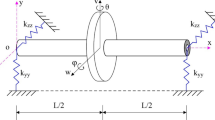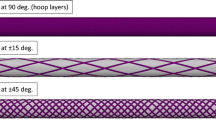Abstract
In conjunction with the homogenization theory and the finite element method, the mathematical models for designing the corss-section of composite shafts by maximizing the torsion rigidity are developed in this paper. To obtain the extremal torsion rigidity, both the cross-section of the macro scale shaft and the representative microstructure of the composite material are optimized using the new models. The micro scale computational model addresses the problem of finding the periodic microstructures with extreme shear moduli. The optimal microstructure obtained with the new model and the homogenization method can be used to improve and optimize natural or artificial materials. In order to be more practical for engineering applications, cellular materials rather than ranked materials are used in the optimal process in the existence of optimal bounds for the elastic properties. Moreover, the macro scale model is proposed to optimize the cross-section of the torsional shaft based on the tailared composites. The validating optimal results show that the models are very effective in obtaining composites with extreme elastic properties, and the cross-section of the composite shaft with the extremal torsion rigidity.
Similar content being viewed by others
References
Bendsoe MP, Kikuchi N. Generating optimal topologies in structural design using homogenization method.Comp Meth in Appl Mech and Engn, 1988, 71: 197–224
Sigmund O. Materials with prescribed constitutive parameters: inverse homogenization problem.Int J Solids Structure, 1994, 31(17): 2313–2329
Lakes R. Foam structure with negative Poisson's ratio.Science, 1987, 235: 1038
Sigmund O. A new class of extremal composites.Journal of the Mechanics and Physics of Solids, 2000, 48: 397–428
Torquato S, Gibiansky LV, Silva MJ, et al. Effective mechanical and transport properties of cellular solids.Int J Mech Sci, 1994, 40(1): 71–82
Sigmund O, Torquato S. Design of materials with extreme thermal expansion using a three-phase topology optimization method.Journal of the Mechanics and Physics of Solids, 1997, 45(6): 1037–1067
Neves MM, Rodrigues H, Guedes JM. Optimal design of periodic linear elastic microstructuresComputer & Structures 2000, 76:421–429
Timoshenko SP, Goodier JN. Theory of elasticity, 3rd ed. New York: McGraw-Hill, 1970
Karihaloo BL, Xiao QZ, Wu CC. Homogenizationbased multivariable element method for torsion of composite shafts.Computer & Structures, 2001, 79: 1645–1660
Sigmund O, Petersson J. Numerical instabilities in topology optimization: a survey on procedures dealing with checkerboards, mesh-dependencies and local minima.Structural Optimization, 1998, 16(1): 68–75
Polya G, Weinstein A. On the torsional rigidity of multiple connected cross-section.Annals Math, 1950, 52: 154–163
Author information
Authors and Affiliations
Additional information
The project supported by the National Natural Science Foundation of China (10172078 and 10102018)
Rights and permissions
About this article
Cite this article
Zhen, Y., Changchun, W. & Hua, L. Homogenization-based topology design for pure torsion of composite shafts. Acta Mech Sinica 19, 241–246 (2003). https://doi.org/10.1007/BF02484486
Received:
Revised:
Issue Date:
DOI: https://doi.org/10.1007/BF02484486




